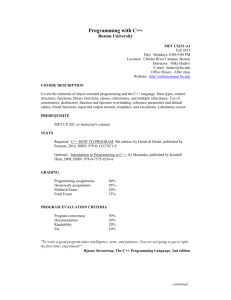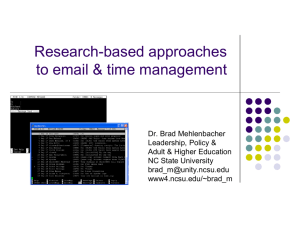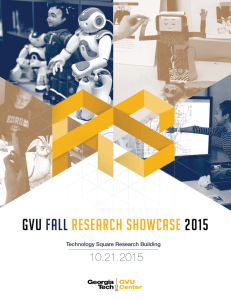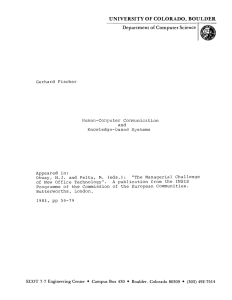Course Description - Department of Computer Science
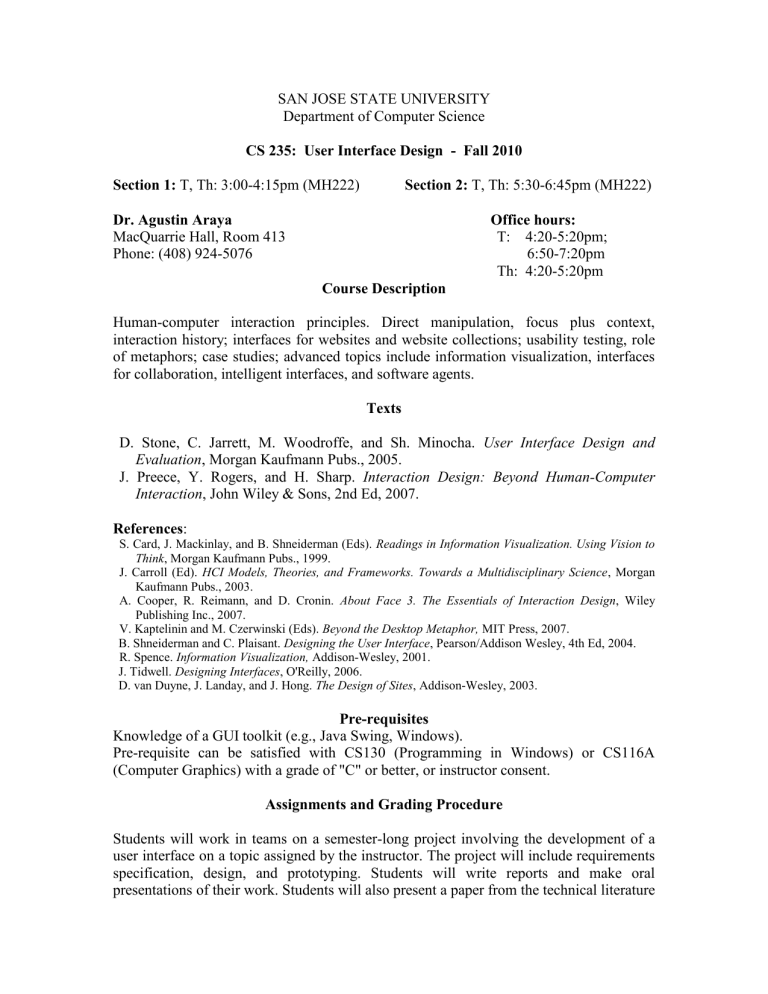
SAN JOSE STATE UNIVERSITY
Department of Computer Science
CS 235: User Interface Design - Fall 2010
Section 1: T, Th: 3:00-4:15pm (MH222) Section 2: T, Th: 5:30-6:45pm (MH222)
Dr. Agustin Araya
MacQuarrie Hall, Room 413
Phone: (408) 924-5076
Office hours:
T: 4:20-5:20pm;
6:50-7:20pm
Th: 4:20-5:20pm
Course Description
Human-computer interaction principles. Direct manipulation, focus plus context, interaction history; interfaces for websites and website collections; usability testing, role of metaphors; case studies; advanced topics include information visualization, interfaces for collaboration, intelligent interfaces, and software agents.
Texts
D. Stone, C. Jarrett, M. Woodroffe, and Sh. Minocha. User Interface Design and
Evaluation , Morgan Kaufmann Pubs., 2005.
J. Preece, Y. Rogers, and H. Sharp. Interaction Design: Beyond Human-Computer
Interaction , John Wiley & Sons, 2nd Ed, 2007.
References :
S. Card, J. Mackinlay, and B. Shneiderman (Eds). Readings in Information Visualization. Using Vision to
Think , Morgan Kaufmann Pubs., 1999.
J. Carroll (Ed). HCI Models, Theories, and Frameworks. Towards a Multidisciplinary Science , Morgan
Kaufmann Pubs., 2003.
A. Cooper, R. Reimann, and D. Cronin. About Face 3. The Essentials of Interaction Design , Wiley
Publishing Inc., 2007.
V. Kaptelinin and M. Czerwinski (Eds). Beyond the Desktop Metaphor, MIT Press, 2007.
B. Shneiderman and C. Plaisant. Designing the User Interface , Pearson/Addison Wesley, 4th Ed, 2004.
R. Spence. Information Visualization, Addison-Wesley, 2001.
J. Tidwell. Designing Interfaces , O'Reilly, 2006.
D. van Duyne, J. Landay, and J. Hong. The Design of Sites , Addison-Wesley, 2003.
Pre-requisites
Knowledge of a GUI toolkit (e.g., Java Swing, Windows).
Pre-requisite can be satisfied with CS130 (Programming in Windows) or CS116A
(Computer Graphics) with a grade of "C" or better, or instructor consent.
Assignments and Grading Procedure
Students will work in teams on a semester-long project involving the development of a user interface on a topic assigned by the instructor. The project will include requirements specification, design, and prototyping. Students will write reports and make oral presentations of their work. Students will also present a paper from the technical literature
user interface design 2 on Human-Computer Interaction. There will be a written midterm and a final exam covering the lecture materials plus a selection of the technical papers. The overall grade will be determined as follows:
Assignments (Project,
Project Presentation, quiz): 30%
Paper Presentation: 10%
Midterm: 25%
Final: 35%
Midterm : Thursday, 10/28 (date subject to change with fair notice)
Final exam : Section 1 : Wednesday, December 15, 2:45 - 5:00pm
Section 2 : Tuesday, December 14, 5:15-7:30pm
Policy for dropping the Course
After the official "drop" day, a student may withdraw from class only for circumstances and emergencies beyond the student's control.
Student Learning Outcomes:
Upon successful completion of this course a student is expected to have the following skills regarding user interface design:
Understand the challenges of user interface design and the roles of techniques and processes
Write requirements including user descriptions, task descriptions, and desired usability characteristics
Develop and document a user interface design including conceptual design and physical design
Apply user interface design patterns in the design of web sites
Justify and/or criticize a design in terms of human-computer interaction principles and design guidelines
Produce different kinds of user interface prototypes, such as paper-based and software-based, suitable to perform usability evaluations
Prepare an evaluation plan to test a prototype or a fully developed user interface
Perform a user interface evaluation according to a previously developed evaluation plan
Understand various approaches to information visualization and support for collaboration
Understand current research themes in Human-Computer Interaction
Additional Information
The hardcopy greensheet is a shortened version of the online greensheet which is available from the web pages of the course.
The online greensheet contains important additional information which you must read.
user interface design 3
Additional Information
How to contact the instructor
The preferred method of communication is face-to-face contact during office hours. You can also contact the instructor during office hours by phone. In addition to my specifically posted office hours, I am available by arrangement. As the project proceeds, at specified times during the semester there will be email communication with the instructor.
Tentative Project Assignment Due Dates (dates subject to change with fair notice) :
Project Phase 1: 9/2/10, 9/14, 9/28
Project Phase 2: 9/28, 10/12, 10/21
Project Phase 3: 11/2, 11/30, 12/2
Calendar of Paper Presentations (dates subject to change with fair notice) :
Th, 9/16/10; Th, 9/23; T, 10/5; T, 10/12; T, 10/19; T, 11/9; T, 11/16; T, 11/23
Additional Grading Information
Letter grades and corresponding scores:
A-: 90-93 A: 94-96 A+: 97-100
B-: 80-83 B: 84-86 B+: 87-89
C-: 70-73 C: 74-76 C+: 77-79
D-: 60-63 D: 64-66 D+: 67-69
F: < 60
Penalty for late homeworks:
1 class late: - 7 points
2 classes late: - 14 points (no submissions allowed after this)
University Regulations
Class Attendance
"Students should attend all meetings of their classes, not only because they are responsible for material discussed therein, but because active participation is frequently essential to insure maximum benefit for all members of the class. Attendance per se shall not be used as a criterion for grading." (University policy F69-24)
Academic Integrity Statement (from the Office of Student Conduct and Ethical
Development)
“Your own commitment to learning, as evidenced by your enrollment at San José State
University, and the University’s Academic Integrity Policy requires you to be honest in all your academic course work. Faculty members are required to report all infractions to the
Office of Student Conduct and Ethical Development. The policy on academic integrity can be found at http://sa.sjsu.edu/student_conduct ."
user interface design 4
Campus Policy in Compliance with the Americans with Disabilities Act:
“If you need course adaptations or accommodations because of a disability, or if you need special arrangements in case the building must be evacuated, please make an appointment with me as soon as possible, or see me during office hours. Presidential Directive 97-03 requires that students with disabilities requesting accommodations must register with
DRC to establish a record of their disability.”
Add/Drop Policy
Please familiarize yourself with the SJSU policy for adding and dropping a course. Every semester the University specifies the last day to drop a course without consequence and the last day to add a course. After these dates it becomes very difficult to drop or add a course.
Other Information and Norms
Cellular Phones
Students will turn their cellular phones off or put them on vibrate mode while in class.
They will not answer phone calls in class.
Computer Use
In the classroom, instructors allow students to use computers only for class-related activities. These include activities such as taking notes on the lecture underway and finding Web sites to which the instructor directs students at the time of the lecture.
Students who use their computers for other activities will be asked to leave the class.





